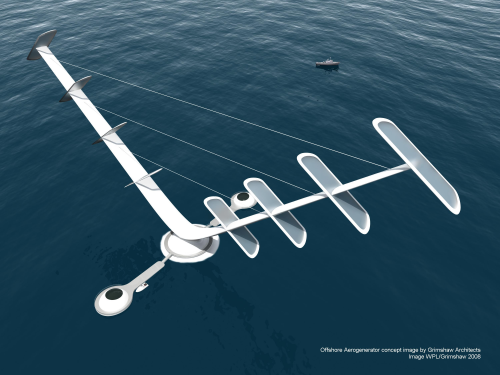
Flying across the North Sea approaching the Dutch coast and Schiphol airport the sight of over a hundred offshore wind turbines sitting in rows like giant gulls upon the turbulent waters is exhilarating. The same buzz is also felt when these 100 hundred metre high horizontal axial high capacity machines are seen off the coast of the British Isles.
An important element in a basketful of viable renewable energy technologies is the current generation of offshore wind turbines which, across the world, have remained structurally sound for the past 40 years.
But construction and installation costs are rising, with mast foundations having to reach down to the seabed for stability, and in tough maritime conditions these are difficult to maintain. Overall efficiency is limited with turbine blades having to be set in the direction of the prevailing winds.
To address this, an all-British consortium has now been given the green light to develop a unique vertical axis winged aero-generator turbine, with a substantial proportion of the funding - around £20 million - from the Energy Technologies Institute (ETi) - composed of private and public monies. The aim is to have 1GW of novel offshore vertical axis NOVA turbines installed by 2014, comprising 200 x 5MW turbines, or fewer larger sized turbines.
The project team led by Wind Power Ltd, which developed the turbine, includes some of the world’s leading R&D groups within the Cranfield, Sheffield and Strathclyde Universities - and private technology solutions provider QinetiQ. The project is managed and led by Guildford, Surrey, UK based offshore energy specialists OTM Consulting. Influencing the turbines’ design / placement to limit any adverse oceanographic environmental impacts will be input from The Centre of Environment, Fisheries & Aquaculture Science (Cefas).
Although the project has a higher risk than installing conventional wind turbines, the spur to the development is the UK’s targets for a greatly expanded supply base. A 5kW prototype has now been built and is now under test at Cranfield University. Preliminary aerodynamic and aeroelastic power models suggest the concept is sound based upon the expertise of David Sharpe, a founder member of the British Wind Energy Association (BWEA) and a man with a formidable background in wind power generation.
The primary advantages are very low overturning moment, where the support structure can be less expensive, and that the nacelle is located at sea level making accessibility easier (along with maintenance) in an encapsulated, corrosion-proof environment.
The positive result will be greater availability. The architectural concept pictured looks as if PV cells could be fitted to the extended vanes, and this reviewer wondered if under any floating support base a deepwater turbine could be fitted.
Professor Feargal Brennan - who is leading the Cranfield team - believes that offshore vertical axis machines can lead to a breakthrough in the creation of offshore wind energy and reduced life-cycle costs, due to few moving parts, and being able to utilise every gust of wind from whichever direction it blows. In addition, he told renewable energy focus, "it’s much easier to move and lift very heavy structures at sea. Also there is no need to go high to catch the wind. After all boats don’t look like trains-there is no reason why offshore wind turbines should necessarily look like onshore machines".
And another big plus compared to existing HAW turbines is that the NOVA machine could potentially be radar friendly, added Brennan.





